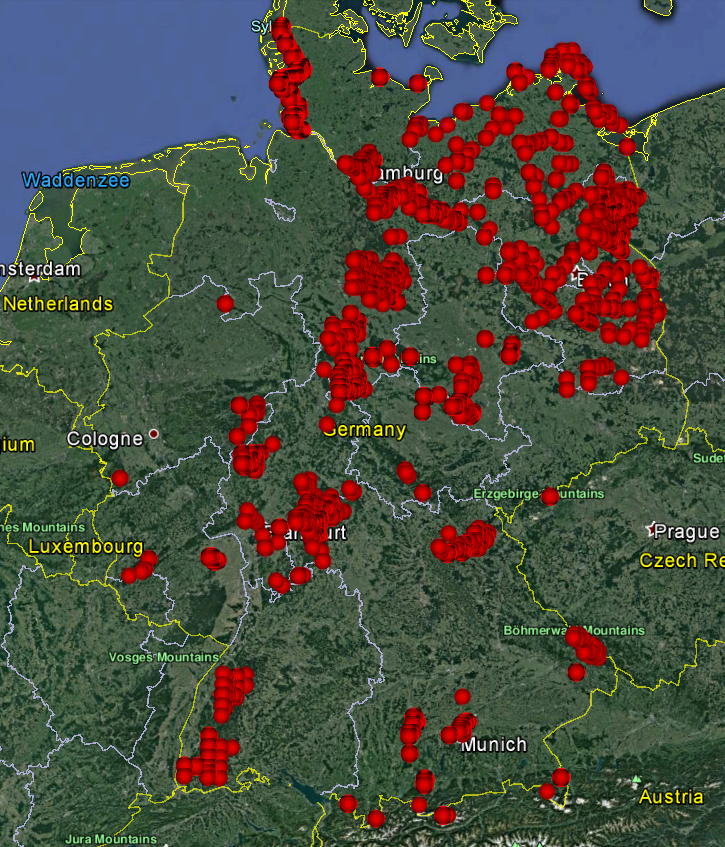This site has moved to https://edgg.org/index.php/databases/Regional-databases and is not maintained anymore on the Ecoinformatics Portal Bayreuth
GrassVeg.DE - German Grassland Vegetation Database (EU-DE-020) – die gemeinschaftliche Graslanddatenbank Deutschlands
This vegetation-plot database, organised by German members of the Eurasian Dry Grassland Group (EDGG), aims at making grassland relevés from Germany available for fundamental and applied research, both within Germany and internationally, while ensuring that data providers get proper credit and benefit. We collect relevés of grasslands and herblands in the widest sense, i.e. everything except forest, shrubland, segetal and aquatic communities. Phytosociologically, the scope mainly refers to the classes Festuco-Brometea, Koelerio-Corynephoretea (including Sedo-Scleranthetea), Violetea calaminariae, Molinio-Arrhenatheretea, Juncetea maritimi (including Saginetea maritimae), Juncetea trifidi, Carici-Kobresietea, Calluno-Ulicetea (including Nardetea strictae), Loiseleurio-Vaccinetea, Salicetea herbaceae, Trifolio-Geranietea sanguinei (including Melampyro-Holcetea), Artemisietea vulgaris (incl. Galio-Urticetea) and Mulgedio-Aconitetea from the territory of Germany. Plot observations from other vegetation classes can be included as well if they form a minor part of a certain contribution. GrassVeg.DE accepts vegetation plots with (0.1-) 1-100 (-400) m² size, for which the cover of the species has been estimated in % or on an ordinal scale (Br.-Bl. scale, Londo scale or similar). Further details on requirements are here...
GrassVeg.DE considers itself as complementary to other German member databases of the European Vegetation Archive (EVA), thus will focus on digitisation of plots not yet contained there. GrassVeg.DE is a collaborative database, self-governed by the data contributors who become members of the GrassVeg.DE Consortium according to the GrassVeg.DE Bylaws. On 10 April 2017, when the threshold of 2,000 plots was reached, GrassVeg.DE joined the European Vegetation Archive (EVA), which will provide the data also to the next release of the global plot database "sPlot", thus making the GrassVeg.DE data available for supraregional analyses (with opt-in authorship options for GrassVeg.DE members) while at the same time providing access to these megadatabases to its members. Persons with suitable plot data are welcome to join!
Foundation: 2016
GIVD: http://www.givd.info/ID/EU-DE-020
Governing Board ("Kuratorium") 2018-2019: Custodian: Jürgen Dengler (Wädenswil & Bayreuth; juergen.dengler@uni-bayreuth.de); Deputy Custodian: Ricarda Pätsch (Hildesheim & Göttingen; ricarda.paetsch@gmail.com); further members: Thomas Becker (Trier; beckerth@uni-trier.de) & Thilo Heinken (Potsdam; heinken@uni-potsdam.de)
Student assistants: Claudia Kurzböck, Marius Klotz (finished)
GrassVeg.DE Consortium (9 May 2018: 40 members): Thomas Becker, Ines Bruchmann, Timo Conradi, Jürgen Dengler, Martin Diekmann, Christian Dolnik, Hauke Drews, Cecilia Duprè, Maike Eisenberg, Hannes Feilhauer, Jamyra Gehler, Bärbel Heindl-Tenhunen, Holger Hauptlorenz, Thilo Heinken, Katrin Henning, Stefan Huck, Elisabeth Hüllbusch, Kai Jensen, Michael Jeschke, Martina Köhler, Patrick Lampe, Nancy Langer, Swantje Löbel, Stephanie Lorenz, Kristin Ludewig, Britta Marquardt, Thomas Michl, Romy Moebus, Anne Nöggerath, Ricarda Pätsch, Dorothee Putfarken, Melanie Rahmlow, Julia Schröder, Oliver Schuhmacher, Julienne Schweiger, Martin Stock, Sigrid Suchrow, Gesine Weiss, Camilla Wellstein, Julia Went
Current content (9 May 2018): 10,371 plots (fast growing)

Federal states: Schleswig-Holstein (31.1%), Lower Saxony (16.6%), Brandenburg (14.8%), Bavaria (10.7%), Hesse (7.4%), Saxony-Anhalt (5.0%), Mecklenburg-Vorpommern (4.8%), Rhineland-Palatinate (2.4%), Baden-Württemberg (2.4%), Hamburg (1.6%), Thuringia (0.5%), Northrhine-Westphalia (0.4%), Berlin (0.2%), Saxony (0.2%), unassigned (1.7%)
Phytosociological classes: Juncetea maritimi (26.3%), Festuco-Brometea (17.6%), Koelerio-Corynephoretea (16.6%), Molinio-Arrhenatheretea (11.5%), Trifolio-Geranietea (5.9%), Mulgedio-Aconitetea (5.6%), Artemisietea vulgaris (5.4%), Calluno-Ulicetea (4.1%), Polygono-Poetea (1.5%), Phragmito-Magno-Caricetea (1.1%), Montio-Cardaminetea (0.7%), other herbaceous classes (1.0%), woody classes (1.3%), unassigned (1.6%)
Plot sizes: 1 m² (30.2%), 10 m² (25.2%), 4 m² (7.4%), 25 m² (6.0%), 5 m² (5.2%), 9 m² (3.7%), 16 m² (3.6%), 20 m² (2.8%), 100 m² (2.3%), other (13.0%), unknown (0.5%)
Precision of coordinates: ≤ 5 m (19.9%), ≤ 50 m (17.7%), ≤ 500 m (28.4%), ≤ 5 km (28.3%), > 5 km (5.7%)
References:



